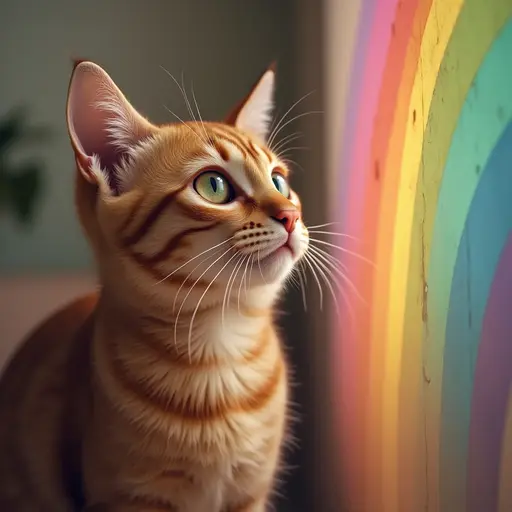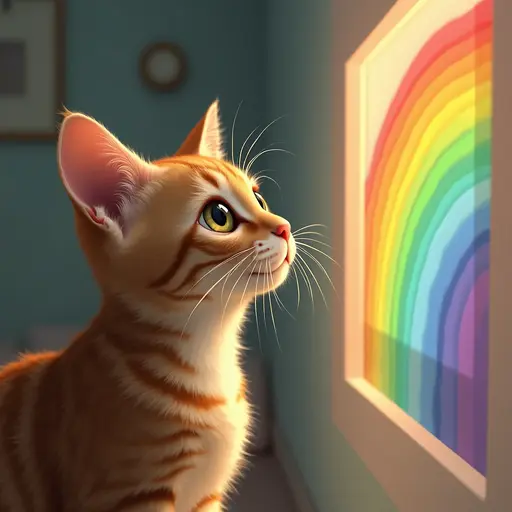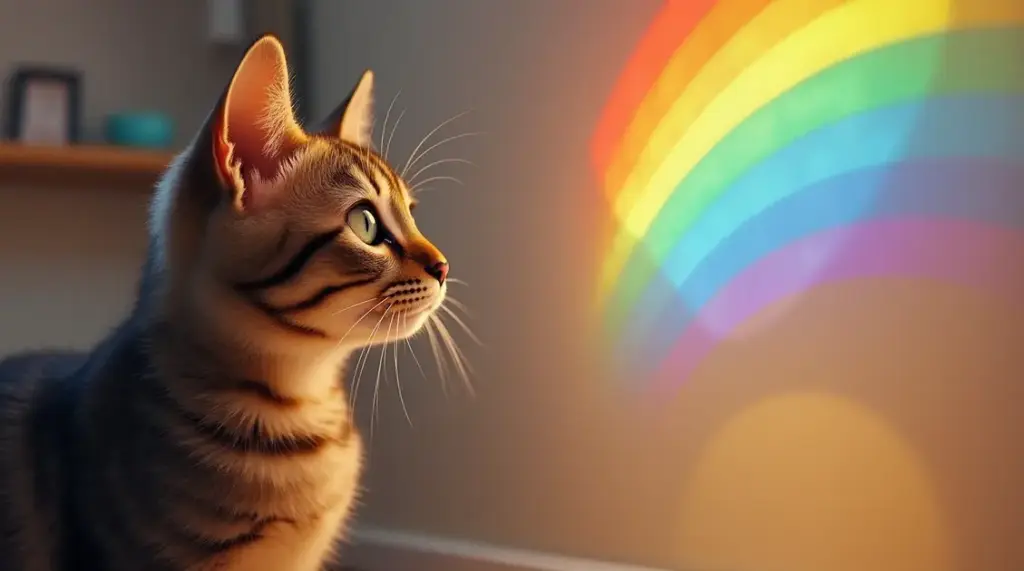The question Can cats see colors? Is a common one among cat owners and enthusiasts. The answer is yes, but their color vision is quite different from ours.
Cats have a specialized visual system tailored for nocturnal hunting, with a unique approach to color perception. Unlike humans, who see a broad spectrum of colors due to three types of cone cells, cats primarily perceive shades of blue and yellow, with limited recognition of reds and greens. This difference arises from evolutionary adaptations prioritizing light sensitivity and motion detection over color diversity, enhancing their ability to hunt in low-light conditions.
Anatomically, cats’ eyes are optimized for night vision. They possess more rod cells, which detect dim light, than cone cells for color vision. Additionally, the tapetum lucidum, a reflective layer behind their retina, improves light capture, enabling them to see in lighting six to eight times dimmer than humans can tolerate and giving their eyes a characteristic glow in the dark.
Cats’ limited color vision impacts their behavior and interactions. Toys in blue and yellow are more engaging for them than those in red or green, aligning with their visual capabilities. Their hunting strategies also benefit, as many prey animals are more visible against blue or green backgrounds, enhancing their effectiveness as predators.
While much is known about feline vision, some aspects remain debated, with ongoing research exploring the nuances of their visual processing. For cat owners, understanding these insights can inform better choices in toy selection and environmental design, contributing to the overall well-being and enriched experiences of their feline companions.
Anatomy of Cat Eyes

The anatomy of a cat’s eyes is specifically adapted to enhance their ability to hunt, particularly in low-light conditions. Cats possess a range of unique structural features that differentiate their eyes from those of humans.
Photoreceptor Cells
Cats’ eyes contain two primary types of photoreceptor cells: rods and cones. Rods are highly sensitive to low light levels, making them crucial for night vision, while cones are responsible for color detection and function best in brighter light conditions.
Cats have a higher ratio of rod cells compared to humans, allowing them to excel in dim lighting.
However, they have fewer cones, especially those that detect red and green wavelengths, which limits their color perception compared to humans.
Tapetum Lucidum
A distinctive feature of cat eyes is the presence of the tapetum lucidum, a reflective layer located behind the retina. This layer enhances night vision by reflecting light that passes through the retina back into the photoreceptors, effectively giving them a second chance to be detected. This is the reason why cats’ eyes seem to glow in the dark when illuminated.
Pupil Shape and Iris
Cats have vertically oriented pupils that can change shape from a narrow slit to a wide circle. This ability allows them to control the amount of light entering the eye, which is essential for adapting to various light conditions. The iris, the colored part surrounding the pupil, contains muscles that adjust the size of the pupil, facilitating rapid adjustments to changing light levels.
Cornea and Lens
The cornea and lens of a cat’s eye also contribute to their visual capabilities. The cornea is larger than that of a human, allowing for greater light capture, while the flexible lens can change shape to help focus on objects at different distances. Together, these structures enable cats to achieve sharper focus and a wider field of vision.
Retina Structure
The retina is comprised of specialized cells that convert light into electrical signals sent to the brain via the optic nerve. The higher concentration of rod cells in a cat’s retina is particularly beneficial for detecting movement, which is essential for hunting.
Additionally, the retina’s structure supports their ability to see well in both bright and dim environments, adjusting to changes in light levels quickly—sometimes in as little as 1/6th of a second.
Can Cats See Color?
Cats possess a unique ability to perceive color, albeit in a more limited spectrum compared to humans. They primarily see shades of blue and yellow, but their color vision is not as vibrant or varied as that of humans, who can perceive a wide array of colors due to their three types of cone cells in the retina.
In contrast, cats have fewer cones, which significantly affects their color perception, leading to a world painted in more muted hues.
Understanding Feline Color Vision
The way cats perceive color is thought to be influenced by their evolutionary adaptations for hunting. Their vision is particularly sensitive to light intensity and wavelength, allowing them to excel in low-light conditions, which is crucial for their predatory behavior.
Cats have a higher concentration of rod cells, which are responsible for night vision, allowing them to see in light levels about six times dimmer than humans.
However, they have fewer cones, especially those that detect red and green wavelengths, which limits their ability to differentiate between certain colors, particularly red and green, which may appear as muted shades.
Behavioral Implications of Color Perception
The limited color spectrum that cats can perceive influences their behavior, particularly in terms of their interactions with toys and hunting strategies. Cats tend to show greater interest in blue and yellow objects, as these colors are more distinct to them compared to red or green.
This preference can be attributed to the fact that many prey animals, such as rodents and birds, are often more visible against backgrounds of blue and green, enhancing their ability to hunt effectively.
Comparison with Human Vision
The processing of color information differs significantly between cats and humans. In humans, color is processed in the visual cortex of the occipital lobe, while in cats, it occurs in the dorsal lateral geniculate nucleus.
This difference in processing may contribute to the distinct ways both species experience color, with cats experiencing a more muted, pastel-like perception of their environment.

The Role of Light and Movement
Cats possess unique adaptations that enhance their ability to perceive light and detect movement, which are critical for their hunting skills. The structure of a cat’s eye, particularly the retina, is tailored for low-light conditions. Cats have a higher concentration of rod photoreceptors compared to humans, which enables them to see in dim environments up to six to eight times better than humans can.
This rod-dominant vision allows cats to excel in low illumination, making them adept nocturnal hunters.
Tapetum Lucidum and Low Light Vision
A significant feature of feline vision is the presence of the tapetum lucidum, a reflective layer behind the retina. This structure reflects light that passes through the retina back towards it, providing a second opportunity for photoreceptors to capture light.
This is the reason why cats’ eyes seem to glow in the dark, as it enhances their ability to see under low-light conditions. The tapetum lucidum contributes to a cat’s ability to track movement and identify prey even when visibility is limited.
Movement Detection
In addition to their sensitivity to light, cats excel at detecting movement. Their visual system is finely tuned for tracking fast-moving objects, which is essential for a predator. The combination of their large corneas, elliptical eye shape, and abundance of rod cells allows them to gather more light and respond quickly to motion.
This heightened sensitivity is complemented by their keen sense of hearing and the use of their sensitive whiskers, which can detect subtle air movements, further aiding their hunting capabilities.
Implications for Cat Behavior and Care
Understanding feline vision has significant implications for how cat owners interact with and care for their pets. This knowledge can influence various aspects, from playtime activities to health monitoring and environmental enrichment.
Play and Interaction
Cats primarily see the world in shades of blue and yellow, with limited ability to distinguish reds and greens. Consequently, selecting toys in colors they can see, such as blue and yellow, can enhance their play experience. Toys that move or make sounds are particularly engaging, as cats are instinctively drawn to motion.
For instance, incorporating striped or patterned toys can further captivate their interest and stimulate their hunting instincts, contributing to their physical and mental well-being.
Environmental Design
Creating a cat-friendly environment involves considering how cats perceive their surroundings. Utilizing textures and patterns that are visually engaging can keep them stimulated and content. Cat owners should aim to design spaces that allow their feline companions to explore and interact with their environment based on their unique visual capabilities.
Social Interaction and Communication
Cats utilize visual cues, including body language and eye contact, to communicate with both other felines and humans. Observing their reactions to different stimuli can enhance the bond between the cat and the owner, allowing for a better understanding of their needs and emotions. For example, slow, gentle gestures can be more inviting to a cat than quick movements, which may startle them.
Owners who engage with their cats using a soft, soothing voice can also foster a more relaxed and trusting atmosphere.
Health Monitoring
Changes in a cat’s vision, including their ability to see colors, can signal underlying health issues. Pet owners should remain vigilant for any alterations in their cat’s behavior that might indicate vision problems, such as difficulty navigating or decreased interest in play.
Regular veterinary check-ups are essential for early detection of potential issues, including conditions like cataracts or retinal damage.
Conclusion
the question Can cats see colors? reveals a fascinating aspect of feline biology and behavior. Cats do see colors, but their visual spectrum is more limited compared to humans, focusing primarily on blues and yellows.
This adaptation is a result of their evolution as nocturnal hunters, where sensitivity to light and motion is more critical than a broad range of color perception. Understanding these nuances of feline vision can greatly enhance our interactions with cats, from selecting the right toys to designing environments that cater to their unique visual abilities.
As research continues to uncover more about how cats see colors, cat owners can use this knowledge to improve the well-being and quality of life of their feline companions, fostering a deeper bond and a more enriching shared experience.



